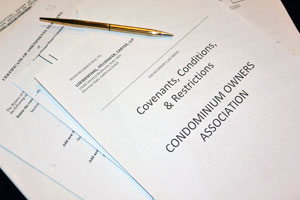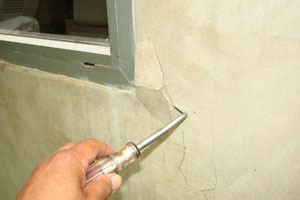The Top Ten List
Homeowners associations, their directors, management companies, lawyers and most importantly, the homeowners themselves can be and frequently are confronted by neighbor to neighbor disputes. If not handled properly, these disputes can get out of control, costing time, money and ultimately impacting the entire association.
This article outlines ten general areas and/or issues existing between neighbors and Homeowners Associations, as well as examples and possible mechanisms to resolve neighbor disputes.
- What right does a homeowner have against a neighbor who may be in violation of the Association’s governing documents?
Since both parties are and hopefully will remain neighbors; it is best to resolve any problems in an informal and collaborative manner. If this is not possible, depending on the specific issues, the aggrieved neighbor may contact the Board. A Board’s failure to take action under such circumstances could be a breach of the Board’s duties and obligations. However, this varies on a case by case basis. Conversely resolution of certain issues affecting one neighbor against another may not be the responsibility of the board. Generally, if the issue affects multiple members then, affects common area, is dangerous, illegal or is an architectural violation; then the board should get involved.
If the neighbor is unwilling to comply with a legitimate request for resolution; the aggrieved homeowner may make a demand for Alternative Dispute Resolution (ADR) pursuant to Civil Code Section 1354 and 1369-510 through 1369.550. These sections generally state prior to the filing of a civil lawsuit pertaining to a dispute regarding the interpretation of the Associations governing documents, a breach thereof, declaratory relief or injunctive relief and the amount in controversy is less than $5,000; the aggrieved party, prior to the filing of a civil action must make a demand for ADR to the aggravating party. ADR allows for mediation, binding arbitration or non-binding arbitration. An aggravating party, when served, has thirty (30) days in which to either accept or reject or not respond to the request. A non-response is the same as a rejection. If there is a non-response or rejection, the aggrieved party may then proceed forward in filing a civil action.
If the parties actually proceed to ADR, and there is no resolution, assuming that it is either mediation or a non binding arbitration, then the aggrieved party can then proceed forward with the filing of a lawsuit. Given the heavy related cost in time and money, a lawsuit should be a last resort and only taken if no reasonable resolution can be reached on a voluntary basis.
- The use of fines by the Association:
Sometimes the only way to obtain a violating neighbors attention is to threaten and sometimes carry out either discipline and/or a fine. Homeowners Associations need to include within their Rules and Regulations a written fine policy that specifically spells out for all of the owners the ramifications for violations of the Association’s governing documents. Generally, but not always, such written policies will provide a warning letter for a first offense and then a stepped up fining policy for each continuing violation. It should be noted that fines are not assessments and therefore cannot be the subject of a lien or foreclosure action. However, an Association can file an action against an owner in small claims court or superior court to collect on such fines.
A neighbor cannot issue fines against an offending neighbor. The Board clearly does have that right as long as they are in compliance with Civil Code Section 1363(h). Prior to the issuance of a fine or other disciplinary action, a Homeowners Association must provide at least ten (10) days written notice to the offending homeowner advising them that the Board will be meeting on a specific date, time and place for the purposes of determining whether or not discipline or a fine will be instituted against the neighbor for a specific violation.
The offending homeowner has a right to attend the hearing and present any information they believe
to be relevant to the Board setting forth why such disciplinary action should not be taken. Within fifteen (15) days of the hearing, the Board must provide a written notification to the offending homeowner as to the Board’s decision. The Board does not have to provide continuous notices and offers of hearings to subsequent violations of the same issue. However, if a single, distinct violation leads to an issuance of a fine and the conduct continues in the future, the Board can continue to issue new fines without having a second hearing. Conversely, if the offending homeowner commences a different violation of a separate and distinct rule then that would be the cause for a new notice, hearing and written position.
- View disputes between neighbors:
Under California law, view rights are not protected, unless you are located in certain scenic corridors that may be protected by City and/or State ordinances or, more generally, the view is protected via the Associations CCR’s. Barring either specific localized City/State protection or the governing documents, view protection is not deemed a protected right under California law.
If the Association CCR’s provide view protection, then the issue is one of absolute protection or partial protection based upon reasonableness. Certain Associations’ governing documents will provide for an absolute protection, i.e. that there can be no impairment or obstruction of view caused by one neighbor against another neighbor.
Two steps which may help prevent view issues are: 1) The owner making the improvement review in advance the association’s documents to ensure that what they wish to construct is compliant and 2) if possible, discuss and reach such agreements in advance between neighbors.
- Neighbor to neighbor noise disputes:
Noise is one of the most frustrating and highly contentious issues that develop between neighbors. Generally attached condominiums and townhomes will have certain standards set forth within their governing documents including the type of flooring material that can be used as well as that which is barred e.g.: wood flooring VS carpeting.
In addition to attempting to designate types of flooring material, the use of the unit can also create problems for both an aggrieved neighbor as well as the aggravating neighbor. Specifically, what bothers or affects one neighbor may be different for another. Noise issues can be evaluated on a scientific level through acoustical tests. However, costs are involved, and subjective opinions may or may not change.
Generally, governing documents will also include a section pertaining to “nuisances” and state that a neighbor’s actions cannot be such that could lead to an unreasonable annoyance, disturbance or offensive activity that unreasonably inhibits another neighbor from using their property.
- Neighbor to neighbor dispute regarding parking issues:
In developments with designated/assigned parking space, parking issues generally center upon street and guest parking. Where Association streets are private and street parking is allowed; disputes arise when one neighbor consistently parks in front of another’s residence. Generally an owners does not have exclusive control over the street parking in front of their residence nor is allowed to use guest parking for their own vehicle(s). However, if one party parks in a manner disallowed by governing documents or municipal ordinances; the homeowner may act against the violating homeowner.
- Neighbor to neighbor disputes for water damage between units:
A serious problem affecting neighbors is water intrusion. Generally this issue arises between neighbors in a condominium or townhome setting where there are attached walls and ceilings. In single family home communities, irrigation water between neighboring lots can also be a source of confrontation.
Generally, if the item that is the source of the water is a separate interest item, such as a washing machine hose, angle stop, etc.; then the owner in control of that separate interest item would be responsible for the costs associated with the damage. Conversely, if the source is a common area source such as a common area pipe, then the costs associated with the remediation and repair fall to the Association.
In most instances, drywall on the ceiling and walls is considered to be common area. Therefore, even if the neighbor refuses to pay for the repair to the drywall; the aggrieved homeowner may have a legitimate claim against the Association since a “common area” has been damaged and the Association is responsible. The Association can generally proceed against the aggravating homeowner and/or their insurer for reimbursements of costs.
- Neighbor to neighbor disputes regarding landscaping:
Landscaping issues typically occur in planned unit developments with single family homes, versus multi-unit. In such instances, the Association’s governing documents generally outline rules for exterior improvement or alteration, including planting and landscaping. Plans and specifications generally must be submitted to the Board and/or Architectural Review Committee (ARC). In many HOA’s, specific restrictions may be set. Disputes may arise over the issue of views. Though as noted above, not all Associations protect views.
Generally, homeowners should attempt to work out these issues via an agreement between neighbors prior to beginning significant landscaping. If a dispute still arises; neighbors, as noted above, can make demands to proceed with ADR. If that fails, the parties may seek judicial intervention.
- Neighbor to neighbor disputes involving tenants and guests:
Frequently, disputes arise between neighbors when one owner is either renting their residence or consistently entertaining guests that are violating the Association’s rules. It is important to remember that violations by tenants and/or guests are ultimately the responsibility of the owner regardless of whether they had actual notice of the violations as they were occurring.
As such, if an owner’s tenants and/or guests are violating the Association’s rules and regulations to an extent that is impacting other neighbors’ ability to reasonably use and occupy their property; then that neighbor would have a right to proceed with an ADR demand, and if that fails, litigation. In the case of a continuing nuisance, the Association can also step in to seek a judicial remedy for such breaches, but in doing so, should consider whether the nuisance is affecting multiple owners or only one. Such claims would be against the owner of the unit since they must comply with the Association’s governing documents. An owner cannot simply say that she/he cannot control his tenants or guests but rather is contractually responsible for the actions of his tenants and/or guests.
9. Pet issues:
Often neighbor disputes relate to pets, most notably dogs. These disputes can range from dogs barking, to leash issues, to dog “poop.” These often are the basis of conflict for neighbors and the Association with an offending homeowner. Laws exist providing certain protections to both associations and pet owners with respect to pet ownership. With proper Association rule amendments, reasonable limitations can be adopted for weight, size, and type of pet so as to avoid dogs with potentially dangerous propensities. Leash laws do apply in most municipalities, as do requirements to clean up after a dog. Thus certain events may violate both the Association’s governing documents and city ordinances.
Given repeated violations of the rules involving pets; the aggrieved homeowner may go to the Board for help. The Board may need to be proactive especially when off-leash issues arise, or the dog is potentially dangerous. The aggrieved homeowner may also contact the local animal control so they may intervene.
10. Conclusion on neighbor disputes:
A flexible and collaborative approach to neighbor disputes is by far the best. If this is not possible, an ADR is a next step and if that fails and the aggravation to the aggrieved neighbor is severe; then the courts are open to them.
People living within a Homeowners Association are covenanting to be bound by certain restrictions and rules. If such restrictions and rules are not acceptable to a homeowner then a home in a common interest development may not be a good choice for them.


